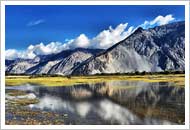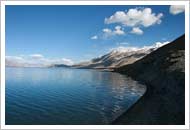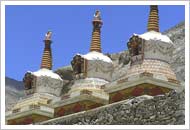Get introduced to the Healthy you, to the Beautiful you, to the Real you
00 91 987 357 9007
Ladakh Lakes and Monastery Tour Package
Delhi - Ladakh - Delhi(14 Days)
Safari to Tso Moriri & Pangong Tso Lakes + Monastery tour
Day 1: Arrive Delhi
Arrival to Delhi and check in the hotel for overnight stay in Delhi.
Day 2: Delhi - Manali Drive to Manali. Check in the hotel and
overnight stay in Manali.
Day 3: Manali Sightseeing and overnight stay at the hotel in Manali.
Day 4 & Day 5: Manali - Leh(Manali to Leh Jeep Safari) Two days
drive from Manali to reach Leh on Day 5.
 Considered as one of the highest roads in the world, Manali-Leh highway is
the most popular and spectacular approach to Ladakh. From the months of end
June to October this highway is open. It’s a very scenic route, full of
adventure and rugged beauty. The road was closed for the civilian use till
1990, but now the adventure and nature lovers worship it, for this road
gives closest contact with nature and thrill of being on the top of the
world is enormous.
Considered as one of the highest roads in the world, Manali-Leh highway is
the most popular and spectacular approach to Ladakh. From the months of end
June to October this highway is open. It’s a very scenic route, full of
adventure and rugged beauty. The road was closed for the civilian use till
1990, but now the adventure and nature lovers worship it, for this road
gives closest contact with nature and thrill of being on the top of the
world is enormous.
Day 4
First day we cross Rohtang Pass (3978 m), Keylong (3350 m), Baralacha Pass
(4890m) with overnight stopover at Sarchu (4253 m), border of the states of
Himachal Pradesh (Lahaul) and Jammu & Kashmir (Ladakh). In Sarchu we
stay overnight in tented campsite.
Day 5
On Day 5, the road from Sarchu crosses high mountain Passes of Namika La
and Lachalung La to reach the army camp in the Pang valley. The dry barren
mountains around Pang are eroded in very spectacular way. They look like
giant fortress like structures with spires, pinnacles and windows. From
Pang, the road climbs up and reaches a different world altogether. Here is
the flat high desert of More Plains, 50-60 km of road bisecting it. This is
Rupshu, an extension of Changthang plateau of Tibet. The road then climbs
for Tanglang Pass (5415 m), the second highest mountain Pass in Ladakh and
then finally reaches Leh. This 475 km Himalayan journey is a visual delight
with not one moment of boredom en route.
Overnight stay in the hotel at Leh.
Day 6: Leh
After breakfast proceed for Indus Valley monastery tour. We start with a
visit to Shey, the ancient capital of Ladakh. The monastery here has a huge
gold-gilded statue of Buddha Sakyamuni with a large silver lamp burning in
front of the statue. Then we visit Thiksey Gompa, an impressive complex
rising tier upon tier on a hill above the village. The monastery has a
beautiful 30 m high gold-plated statue of Maitreya Buddha, the Buddha of the
future. Drive further to visit the famous Hemis Gompa, founded in 1630's by
Stag-tsang-ras-pa under the royal patronage of Sengge Namgyall. Hemis is one
of the largest and richest gompas of Ladakh. The two-day festival of
monastic dance in June-July has raised the reputation of Hemis particularly
high. The festival is dedicated to Guru Padmasambhava, popularly known as
second Buddha and responsible for spreading Buddhism in the Tibetan world.
Later we visit the Stok Palace, the Royal residence of the King of Stok &
the Museum that has a rich collection of Ancient Ladakhi artefacts including
old Thangkas, precious stones, arms and armoury, the Queen’s necklace
and the crown of the King of Ladakh among others. Overnight stay at the
hotel in Leh.
Day 7: Leh - Karu - Pangong Tso Lake (7-8hrs)
 After early breakfast we drive to Pangong Tso Lake. From Leh we reach Karu,
an Army camp on Leh-Manali road and then turn left and cross Changla Pass
(17500 ft) and finally to Tangtse. Evening at leisure. Overnight stay little
beyond Tangtse in tented camp at Lukung near Pangong lakeshores.
After early breakfast we drive to Pangong Tso Lake. From Leh we reach Karu,
an Army camp on Leh-Manali road and then turn left and cross Changla Pass
(17500 ft) and finally to Tangtse. Evening at leisure. Overnight stay little
beyond Tangtse in tented camp at Lukung near Pangong lakeshores.
Pangong Lake, situated at 14,000 feet (4,267 m), is a long narrow basin of
inland drainage, hardly six to seven kilometres at its widest point and over
135 km long. About 1/3rd of the lake is under Indian occupation and
remaining under China. The Chinese border is just beyond the mountains
across the lake. Spangmik, 7 km along the southern shore from the head of
the lake is the farthest point to which foreigners are permitted. There are
spectacular views of the mountains of Changchenmo range to the north and
their shimmering reflection in the ever-changing blues and greens of the
lake’s brackish waters is breathtaking. Above Spangmik are the glaciers
and snow-capped peaks of the Pangong range. Spangmik and other scattered
tiny villages along the lake’s southern shore are the summer homes of a
scanty population of Chang-pa, the semi-nomadic herdsmen of Tibet and
southeast Ladakh. The Pangong Chang-pa cultivate sparse crops of barely and
peas in summers. During the winters that they pack their tents (rebo) and
take their flocks of sheep and pashmina goats out to the distant pastures.
Day 8: Pangong Tso Lake - Leh
We drive back to Leh the same route and overnight stay in the hotel.
Day 9: Leh - Likir - Alchi - Lamayuru
 After breakfast we drive to Likir and visit Likir gompa situated atop a
windy cliff top overlooking the beautiful village of Likir. It was founded
in the 12th Century although the present construction dates back to the 18th
century as the original one was destroyed by fire. In its courtyard is a
yellow-coloured 3 storey high mammoth statue of the Lord Buddha, which was
constructed by a resident monk. The top floor has an impressive museum
containing old tangkhas and weapons used many centuries back.
After breakfast we drive to Likir and visit Likir gompa situated atop a
windy cliff top overlooking the beautiful village of Likir. It was founded
in the 12th Century although the present construction dates back to the 18th
century as the original one was destroyed by fire. In its courtyard is a
yellow-coloured 3 storey high mammoth statue of the Lord Buddha, which was
constructed by a resident monk. The top floor has an impressive museum
containing old tangkhas and weapons used many centuries back.
Then we drive and cross the River Indus and reach Alchi, Ladakh's most
loved monastery. Over a century old, its wall paintings are very similar to
those of the Tabo gompa in Spiti, Himachal Pradesh. Unlike other
monasteries, which are usually on a cliff top or cling to a mountainside,
Alchi is at ground level and is nestled in the shade of a garden.
After Alchi, we have an option to visit the impressive Ridzong Gompa,
reached from the road head after a 30-minute uphill walk. It’s an
impressive monastery well hidden in the lap of the mountains until you’re
face to face with it. It is situated on the mountainside wedged in between 2
ends of a ridge. It is about 100 years old and the name means 'mountain
fort' aptly describing this isolated Gompa. It also has a nunnery of female
monks.
Finally we reach Lamayuru monastery, founded by Rinchen Zangpo in the 10th
century. This Gompa is located amidst the massive mountains. The spectacular
setting of this Gompa and its renowned collection of carpets, tangkhas, and
frescoes has been attracting many people over a long time. It is believed to
be the oldest in central Ladakh.
Overnight stay in Lamayuru.
Day 10: Lamayuru - Leh(124 km)
In the morning we visit the Lamayuru monastery to be part of the morning
religious ceremony. It’s a very soothing and spiritual experience to be
there among these warm and friendly monks. On our way back to leh we can
visit Basgo monastery famous for its statue of Buddha. Overnight stay at the
hotel in Leh.
Day 11: Leh - Upshi - Tso Moriri (Karzok Gompa): 8-9 hrs
After early breakfast, we drive to Karzok (4,572 m) the only village near
Tso Moriri Lake. From Leh we reach Upshi on Leh-Manali road and then we turn
to another valley and drive along the Indus River. It is one of the most
interesting areas and goes through narrow valleys, sandy deserts, rocky
paths, and our vehicle crosses number of mountain streams. Little before
Tso-Moriri Lake we drive past a small green valley of wild Marmots locally
known as Phya. Arrive at Korzok village and check in at the camps. Situated
at 15,000 ft (4,572 m), it is the only permanent settlement in Rupshu region
with an approximate population of 500 people. The few barley fields at
Karzok must be among the highest cultivation in the world. In the evening we
visit Karzok monastery. Overnight stay in the tented camp.
Day 12: Tso Moriri Lake (Karzok gompa)
Day free to explore the Lake area and the village.
The clear blue Tso Moriri lake is one of the most breathtaking lakes in
Ladakh. This brackish water lake is considered sacred by the locals. The
Lake is surrounded by beautiful. The Lake is a breeding ground for numerous
species of birds like Great Crested Grebe, the Brahmini duck, Bar Headed
Geese, etc. This region also has large number of Kiangs, Tibetan wild ass
and it’s not difficult to spot them.
Overnight stay in the tented camp.
Day 13: Tso Moriri Lake - Tso Khar Lake - Tanglang La Pass - Leh
In the morning, we drive to reach Tsokar via Puga by covering 75 km in 3-4
hours. Tso Khar Lake (4485 m) is also called White Lake because of salt
deposits around it. It is approx 45 km northwest of the Tso Moriri Lake. Tso
Khar is so salty that salt extracted from its margins are still sold all
over Ladakh. We continue to drive and reach Manali-Leh highway and drive
down towards Leh via Tanglang-la (5415 m) the 2nd highest motorable road in
Ladakh. En route, drive pass beautiful villages of Rumtse, Gya, Miru and
Lato. Arrive Leh and check into hotel for overnight stay.
Day 14: Leh - Delhi: Fly
In the morning transfer to the airport to board the flight to Delhi.
Transfer and check in the hotel in Delhi.
-
 India Wellness Tours
India Wellness Tours - Ayurveda at Ananda, Rishikesh
- Ayurveda at Somatheeram, Kovalam
- Ayurveda at Travencore, Kovalam
- Uday Samudra Beach Resort, Kovalam
- Nikki's Nest, Kovalam
- Dr. Franklins Panchkarma Institute, Trivandrum
-
 Ayurveda in India
Ayurveda in India - About Ayurveda
- Origin and History
- Kerala Ayurveda
- Ayurvedic Therapies
- Ayurveda in Daily Life
- Ayurvedic Medicines
- Ayurveda Resorts / Shalas
- Kerala Ayurveda Resorts
-
 Yoga in India
Yoga in India - About Yoga
- Origin and History
- Types of Yoga and Yoga Positions
- Yoga Therapies
- India Yoga Centers
-
 Meditation in India
Meditation in India - About Meditation
- Origin and History
- Techniques and Postures of Meditation
- Benefits of Meditation
- India Meditation Centers
-
 Spa in India
Spa in India - About Spa / Introduction
- Origin and History
- Spa Treatments
- India Spa Resorts
- Ananda Spa Resort
-
 Homeopathy in India
Homeopathy in India - About Homeopathy
- Origin and History
- Homeopathy Remedies
- Homeopathic Medicines
-
 Naturopathy in India
Naturopathy in India - About Naturopathy
- Origin and History
- Naturopathy Treatments
- Naturopathy Centers in India
Copyright © 2020, www.IndiaWellness.org
Recognized by Ministry of Tourism, Government of India
National Tourism Award Winner
Powered by SOFTTIX






